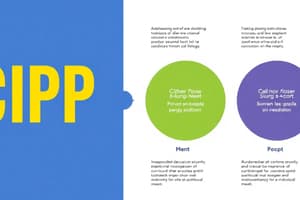Podcast
Questions and Answers
Which of these letter sequences appear in the provided content, in the order listed?
Which of these letter sequences appear in the provided content, in the order listed?
- x, y, z
- a, b, c (correct)
- u, v, w (correct)
- p, q, r (correct)
The letter 'f' appears before the letter 'g' in the provided content.
The letter 'f' appears before the letter 'g' in the provided content.
True (A)
What is the letter that immediately follows ‘j’ in the provided content?
What is the letter that immediately follows ‘j’ in the provided content?
k
The letter 't' is followed by ______, according to the content provided.
The letter 't' is followed by ______, according to the content provided.
Match the letter groups with the number they appear to be associated with in the provided content:
Match the letter groups with the number they appear to be associated with in the provided content:
Flashcards
String
String
A sequence of characters, such as letters, numbers, and symbols.
Float
Float
A data type that represents numbers with decimal points.
Integer
Integer
A data type that represents whole numbers, both positive and negative.
Dictionary
Dictionary
Signup and view all the flashcards
List
List
Signup and view all the flashcards
Study Notes
Curriculum Models and Expenditures
- Curriculum models emphasizing learner-focused interactions between student characteristics and instructional approaches are discussed.
- Types of expenditures are defined, including support, capital, reserve, central administration, and benefit.
Group Decision-Making Types
- Different types of group decision-making are categorized: free, developmental, limited, closed, and open.
National Staff Development Council (NSDC)
- NSDC focuses on content, implementation, process, data, and context.
Assessment Types
- Various assessment types are detailed, including norm-based, multiple-choice, criterion-based, open book, and ipsative assessments.
Family Educational Rights and Privacy Act (FERPA)
- FERPA is mentioned, likely as a relevant legal framework.
Cooperative Learning Model
- This model, potentially focusing on teamwork and collaboration, is noted.
Reinhartz and Beach's Self-Assessment Model
- A six-step self-assessment model developed by Reinhartz and Beach is mentioned.
Principal Responsibilities
- Principal responsibilities, including affirmation, optimization, relationship building, visibility, and focus, are outlined.
Elementary and Secondary Education Act (ESEA)
- Title I of the ESEA (Elementary and Secondary Education Act) and its implications are noted.
Types of Learning
- Types of learning, including transitional, cultural, political, and technical learning, are highlighted.
Funding and Budgeting
- Six steps of the budgeting process are described, focusing on needs assessment, goal setting, objective creation, program development, budget creation, and result assessment, as well as funding by an enterprise.
Cooperative Learning Instructional Method
- The International Society for Technology in Education (ISTE) implemented five technology standards (visionary leadership, digital age learning culture, excellence in professional practice, and systemic) are highlighted.
Zero-Based Budgeting
- Zero-based budgeting as a budget type is noted.
Further Budget Types
- Different types of budgeting are categorized – sequential, elective, residential, incremental, allocated.
Curriculum Types
- Different curriculum types are classified (taught, recommended, learned, organic, perceived).
Leadership Models
- Transformational leadership (idea by Bass) and a 5-step action research process (Calhoun and Sagor) are noted.
Clinical Supervision Models
- A clinical supervision model with six steps (preconference, observation, data gathering, information analysis, post-conference, and follow-up) is described.
Ecological Theory
- Four systems (microsystem, mesosystem, exosystem, macrosystem) that comprise the ecological theory are defined, emphasizing the interaction between individuals and their environment.
Studying That Suits You
Use AI to generate personalized quizzes and flashcards to suit your learning preferences.




